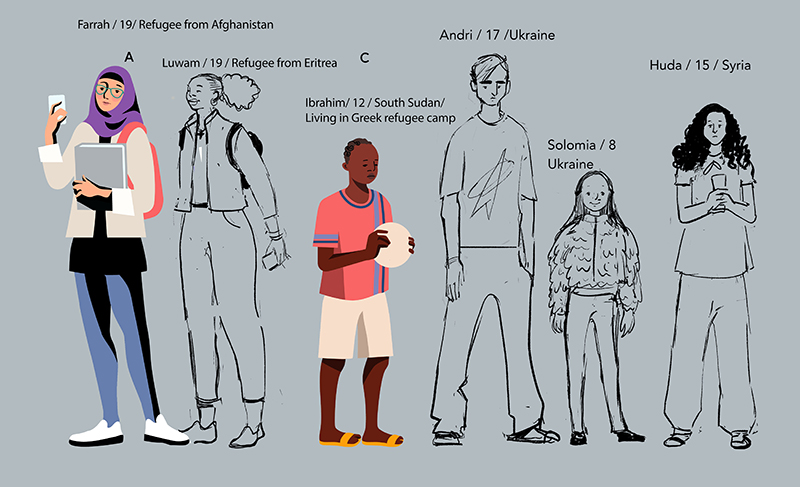Childhood Trauma, War & Conflict
Using the powerful medium of animation storytelling, this film was created to help inform and help young people cope with common physical and emotional responses to trauma, caused by experiences of war and conflict.
Once in a while, a project comes along that not only captures our creative imagination but resonates so deeply, that it goes beyond a usual animation commission.
The Background
The UK Trauma Council (a project of mental health charity, Anna Freud) are a group of childhood trauma specialists. They contacted us with a brief to create an animation, specifically highlighting trauma for young people (12-21 years) impacted by war and conflict. This initiative was motivated by the devastating war in Ukraine but is sadly ever-relevant to young people from all around the world.
The UKTC had realised the severe lack of resources available specifically for young people, on how to cope with negative feelings created through their lived experiences of war and conflict. They wanted to commission this animation (alongside additional online resources put together by UKTC) to help. Their aim was to use storytelling to help inform young people about common physical and emotional responses to trauma and in turn, normalise those responses; showing the importance of social connections in addressing the impact of these memories.
Collaboration
From start to finish, this job was a highly collaborative experience. We worked hand-in-hand with the leading researchers and clinical experts at the TCUK, and also with a hugely articulate and inspirational group of young people from the Kent Refugee Action Network (KRAN). This group had lived experiences of war and conflict, and crucially guided us on how to make the animation useful and relevant to the young people it was trying to reach.
Creative and Narrative Direction
Coming up with a creative concept was no mean feat. It was important we represented a range of common PTSD symptoms caused by negative lived experiences, without creating scenarios that could be triggering. It was also essential we shared coping mechanisms, whilst being mindful that finding a path away from traumatic experiences will be hard, and different for everyone.
We went through every possible approach; from emotive visuals that focused on abstract shapes, to a range of metaphors which could symbolise the impact of trauma on a young person. Ultimately, our collaborative process led to the idea of shattered reflections.
Using the reflective device, we were able to represent real-life characters whose worlds literally break apart in triggering situations. In turn, as coping strategies are introduced within the narration, these fragments could begin to reform and heal. Illustrating the critical messaging; that although traumatic memories may always be part of these children’s lives, it doesn’t have to define them or their future.
Character Development and Animation
To tell this story, we all agreed that representing real human characters and locations was important in evoking an emotional connection with the subject matter. So a few workshops later, we came up with a fictional cast of young people to appear in the animation, who would tell their stories through first-person narration.

This was the moment we commissioned the brilliant illustrator Lilian Darmono, to start bringing the characters to life. Our cast was designed to provide a rounded representation of situations and experiences the target viewer might relate to or have experience of.
The vector characters were placed into painterly scenes that gave context to their stories and geographical locations. Every detail was discussed with our young advisors, from clothing to pets(!), to ensure the authenticity of each of the characters' stories came across.

Storytelling to Help Inform
Insights on the effects of trauma from the experts at UKTC helped to create narratives for each character. This was especially important as in some languages there is no word for "trauma" or "PTSD". So giving young people the tools to recognise the cause and effect of their symptoms, was an important part of the process.


Thoughtful character animation brought the illustrated settings and characters to life, and helped connect with the individual stories. Some of our characters were living in active warzones, whilst others were in places of safety, but still experiencing symptoms associated with PTSD.


The second part of the animation focused on a turning point for our narrative. We hear each character highlight the importance of social connections, as a way to move away from the negative responses they are experiencing.

The shards representing broken pasts begin to reform. Highlighting a turning point as our character begins to take control of their future.
The hopeful scenarios hint at the possibility of healing through social connections. Using gentle language to instil a feeling of positivity, even in situations that are still unstable.

Additional Resources
In addition to the animation, we also produced still images and social content for two downloadable toolkits titled Childhood Trauma; Migration and Asylum. These were produced for staff and volunteers, working in education or the wider community in the UK with children and young people who have sought refuge and asylum, often as a result of war and conflict.


Sharing the Film
The animation has been shared through an extensive network of social media and networks. The channels chosen were based on research by UKTC and within our workshops with young people, for the best ways to reach a worldwide audience with access to varying levels of technology.
To help with this global distribution, the animation and accompanying resources have been translated into Arabic, Farsi, Hebrew, Pashto, Tigrinya and Ukrainian.
The animation was also accepted into the Charity Film Awards 2024. The awards have one objective: to increase engagement of films submitted and help get the entries seen by the widest possible audience. So we hope this has contributed to helping the film reach the young people who will really benefit from its messaging.
We are so proud to be a part of this collaborative process and hope this animation does what it can to help young people affected by war and conflict, see a brighter future beyond their past experiences.
